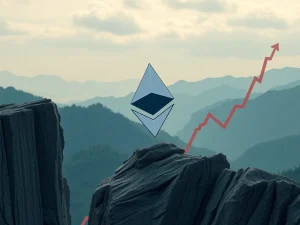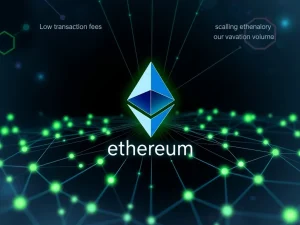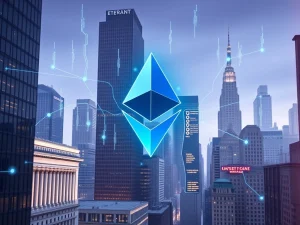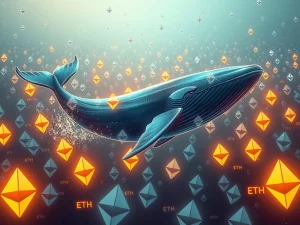Ethereum Metrics: Decoding 2 Crucial Narratives Shaping Its Future

A recent declaration about Ethereum’s health has sparked intense debate. A Messari analyst controversially stated that Ethereum is ‘dying.’ This claim emerged after a significant drop in network revenue. However, many in the crypto community strongly disagree. They point to a vibrant and expanding Ethereum ecosystem. This article delves into these two very different stories. We will explore the conflicting Ethereum metrics and what they mean for the network’s future.
Decoding the Decline in Ethereum Revenue
Messari research manager AJC ignited a heated discussion. On Saturday, he posted on X, claiming Ethereum’s fundamentals were ‘collapsing.’ His argument centered on a sharp decline in Ethereum revenue. Specifically, Ethereum’s fee revenue in August totaled $39.2 million. This figure represented a more than 40% drop year-over-year. It also marked approximately a 20% decrease month-over-month. Such figures, AJC suggested, painted a grim picture for the blockchain.
The primary driver behind this revenue fall is clear. The Dencun upgrade, implemented in March 2024, played a significant role. This upgrade notably lowered transaction fees for layer-2 scaling networks. These networks use Ethereum as their base layer. They post transactions efficiently and cost-effectively. Consequently, the core network collects less in fees. For some, this revenue dip signals a fundamental weakness. Others view it as a strategic evolution.
A Thriving Ethereum Ecosystem: Beyond Just Fees
Many experts offer a different perspective. They argue that judging Ethereum solely on revenue is flawed. Henrik Andersson, CIO of Apollo Crypto, believes Ethereum is far from dying. He points to robust data from Ethereum L2s analytics tool growthepie. This data shows a truly ‘vibrant ecosystem.’ Key Ethereum metrics support this view. Stablecoin supply, network throughput, and active addresses are all at or near all-time highs.
Furthermore, daily active addresses on Ethereum show remarkable growth. As of August 30, over 552,000 daily active addresses were recorded. This figure represents a substantial 21% increase since the same time in 2024. These user engagement statistics highlight continued network utility. They suggest strong underlying demand. Therefore, these metrics offer a powerful counter-narrative to the revenue-centric critique.
The Persistent Debate on ETH Price and Valuation
The discussion around Ethereum revenue extends to its valuation. Andersson emphasizes that Ethereum should not be valued like a tech stock. Instead, he views it as a commodity. Just like Bitcoin is a store of value, Ethereum serves as a decentralized base layer for finance. Therefore, its value transcends mere revenue generation. This perspective challenges traditional financial analysis methods when applied to blockchain assets.
Conversely, AJC defended his revenue-based valuation. He noted that fees are collected in Ether (ETH). He argued that one of the largest historical demand drivers for ETH consumption is ‘trending toward zero.’ AJC also dismissed active addresses and transactions as ‘meaningless statistics’ regarding demand. This highlights a fundamental disagreement. The debate focuses on which metrics truly reflect the health and future potential of ETH price.
Layer-2 Scaling: Ethereum’s Strategic Evolution
The Dencun upgrade was a deliberate move. It aimed to enhance Ethereum’s scalability. By reducing fees for Layer-2 scaling solutions, Ethereum fosters growth. This strategy allows L2s to process transactions more cheaply and quickly. This offloads congestion from the mainnet. Consequently, the overall network becomes more efficient. This approach is vital for supporting a global, decentralized finance infrastructure.
The success of these Layer-2 networks directly benefits the broader Ethereum ecosystem. They expand its capacity. They also attract more users and developers. This expansion is crucial for long-term viability. It ensures Ethereum remains competitive. It also strengthens its position as a foundational blockchain. This strategic shift is designed for future growth, not decline.
Navigating the Competitive Landscape for Ethereum
Ethereum has faced ‘death’ declarations many times. Since 2014, it has been declared dead at least 150 times. Approximately 40 of these instances occurred this year alone. Ryan McMillin of Merkle Tree Capital suggests these declarations often emerge during narrative weakness. They appear when fees fall or competitors seem to gain ground. However, Ethereum consistently adapts.
Its robust developer community is a key strength. Entrenched DeFi protocols also contribute significantly. Furthermore, increasing regulatory acceptance provides stability. These factors give Ethereum remarkable staying power. While competitors like Solana offer faster and cheaper alternatives, Ethereum’s ecosystem remains deeply rooted. The network’s resilience is a testament to its foundational role.
The Impact of Spot ETFs on Ethereum’s Future
Spot exchange-traded funds (ETFs) for Ether marked a significant milestone. They unlocked traditional finance flows into the asset. This development positioned Ether as a levered play. It connected ETH price directly to stablecoin adoption and network growth. These ETFs provide mainstream capital access. They validate Ethereum as a serious investment vehicle.
However, this advantage may not last indefinitely. Spot Solana ETFs are anticipated in the coming weeks. Such developments could quickly level the playing field. Mainstream capital inflows would then diversify. The broader crypto market is maturing rapidly. It is evolving into an ecosystem of differentiated assets. Despite this competition, Ethereum is poised to remain a central piece for years to come. Its adaptability and strong foundation are key to its enduring presence.
The current debate around Ethereum metrics highlights its complex nature. On one hand, falling revenue figures present a challenge. On the other, a flourishing Ethereum ecosystem, powered by Layer-2 scaling, shows immense vitality. The future of ETH price will likely depend on how these two narratives evolve. Ultimately, Ethereum continues to innovate and adapt. It maintains its crucial role in the evolving digital economy. This ongoing competition fosters a healthy and dynamic blockchain environment.








